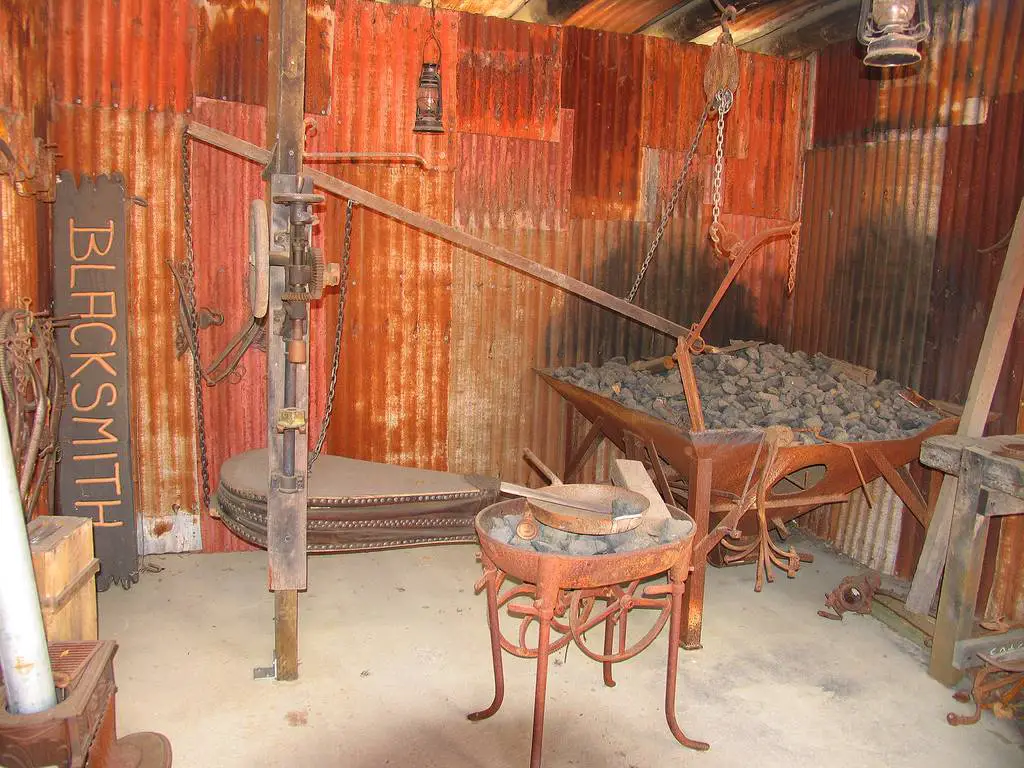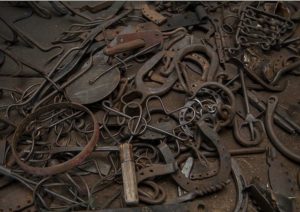
Blacksmithing is a rare hobby in that you can get by without really purchasing anything but your steel stock. You can make your own tools! The techniques are timeless as well, meaning the techniques you learned 10 years ago will work just as well today.
But how do you begin forging if you have no tools at all? Or maybe you don’t want to make boring tools like hammers and tongs, maybe you want to jump right in to the fun stuff…
In this case, it can make sense to buy a starting kit that will get you up and running faster. Note: you will pay something (money or time), regardless of whether you choose to buy your tools or to scavenge for them. Scavenging around junkyard and antique shows costs time, time that could be spent doing fun or productive things. Which path sounds more efficient to you?
This makes the idea of buying a kit that contains everything you need for smithing very enticing. Sadly, the kits currently for sale on the market come at huge premiums in relation to the underlying tools.
Luckily it’s not too hard to buy the individual pieces. It’s worth it to do it this way, you can save quite a bit of dough by buying the pieces 1 by 1. This what I did and it’s what I recommend for others.
Still, it helps to have a bit of organization. So I tried to compile a list of all the tools you will need to get started. This makes it easier to keep track of what you need. I also provide plenty of links if you are looking for more in-depth guides on individual tools.
So let’s get started shall we?
Finding a Hammer For your Forge
In the noble art of blacksmithing, the stock is worked by repeatedly beating it with a blunt object. It’s pretty straight forward, as such, I wouldn’t worry too much about this part of the project.
The main key is to buy something that will be comfortable, as the “blacksmithing elbow” is a very really phenomenon.
I love my 3lb Stanley Fatmax AntiVibe Hammer. It’s a traditional cross pein and comes with lots of bell and whistles to improve comfort.
If this isn’t quite what you are looking for, check out my article on forging hammers as I go over some more unusual hammers such as the french cross peen or the Swedish cross peen hammer.
Finding A Tong For Your Forge
Whether you’re making knives, weapons, armor, tools, or ornamental work, you are going to need a way to grip your piping hot stock. As you advance in your craft you will eventually find yourself making custom tongs that are well suited for a particular job.
But when you are first starting out, it makes sense to buy a pair of generalist tongs. Making tongs without an original pair of tongs is doable, but unnecessarily tricky when you are a beginner.
But which type should you get? There are A LOT of different shaped heads for forging tongs. Here is just a primer:
- Bolt
- Pickup
- Flat Jawed
- Straight Lipped
- Snips
- Bow tongs
- Semi-Box
- Side Lipped
- Hammer
- Wedge
- Side
- Adjustable
- Round Nosed
- V-Bit
- Box Tongs
- Bolt Jaw Tongs
- Wolf Jaw
- And more, as many tongs are custom made!
When you are a beginner blacksmith, this can be detail overload.
For your first pair I recommend a 16” V-Bit tong. These are a comfortable length for a pair of tongs but more importantly the V-Bit head is VERY versatile.
V-Bit heads are adept at gripping both round and square stock. In addition, they are great for knife making.
I’m not too familiar with farrier work, so I’m not sure how suited they are to gripping horse shoes. My guess is that there are better options out there for this type of work.
This article is just a quick guide to help you throw together a blacksmithing kit asap. If you are interested in other varieties of tongs, I recommend you check out my Guide On Forging Tongs, where I also go over the popular wolf jaw tong.
Anvil
If your hammer is the unstoppable object, then your anvil is the immovable one. God help the pieces of steel that get in your way! Overused paradoxes aside, the anvil is one of the most iconic tools in the blacksmith’s proverbial tool belt.
The anvil, along with the forge, is probably one of the trickiest parts of a smithing kit for newbies. Most anvil guides will tell you that steel faced anvils are the way to go, and I will tell you the same. Sadly, steel faced anvils are SIGNIFICANTLY more expensive than other alternatives.
Steel anvils are much less likely to chip or crack, especially when compared to cast iron anvils. They are also easier to repair should you dent them. But if you are a just starting out in blacksmithing, the price tag is a real problem.
Which begs the question, which type of anvil should you get? Should you get the more expensive option that will last a long long time? Or should you get a cheaper anvil to practice on so that you can see if you even like this hobby? I can’t really answer this for you.
I started with a cast iron anvil. I beat the living crap out of it, it’s very ugly and full of hammer sized dents now. But it allowed me to cheaply feel the thrill of smith work. I eventually moved on to a steel faced farrier anvil. This worked out well as I was able to practice my motor skills a bit before shelling out a lot of money on an expensive anvil. I would much rather ding up a cheap anvil as a beginners than an expensive nice one.
If you’re snarling at the price tag of these anvils, remember that anvils are heavy, niche products made of expensive material. If you are looking for more information as to why anvils are expensive, check out my article Why The Hell Are Anvils So Expensive.
Unless you plan on using the earth as an anvil – which is possible by the way, it’s just not practical, or efficient, especially if you want your work to look, well, good – you are going to have to make some hard decisions on an anvil purchase.
Forge
If you are looking to buy a pre made solution, the forge is the last big ticket item in your blacksmithing kit.
It can be pretty hard to find a high quality forge that is for sale. This is why I personally chose to go the JABOD route: Just A Box Of Dirt. It requires a little setup, but it’s dirt(lol)cheap. A picture is worth a thousand words, so if you are interested in this type of forge, I recommend checking out this video by Torbjorn Ahman . I apologize for being too lazy to look up the Swedish characters for his name.
The only downside of the JABOD that it only works with solid fuel forges.
A JABOD forge also doesn’t help you if you are looking for a pre-made forge or a propane burner forge. In that case I would consider this propane forge made by hell’s forge
I haven’t used it personally, but it seems to be of fairly high quality based on the reviews.
Propane forges have a number of advantages over solid fuel forges in that they are:
- Easy to setup and put away
- Compact
- Much cleaner – no soot
- A well designed propane forge will heat up very quickly.
- More consistent temperatures
- Need less fire management
While my JABOD forge serves me just fine, there are some real advantages to a propane burner forge. It’s up to you to decide which is best for you.
If you are interested in a more in-depth look at forge fuels, check out the best forge fuels.
Work Clothes
If you have a hammer, a pair of tongs, an anvil, and a forge, you have the fundamentals taken care of, and you are pretty much set to go.
That being said, It’s worthwhile to spend some time thinking about what you will wear while smithing. While I have seen people smith like wild shirtless vikings, the fact is that molten scale burns you. This doesn’t feel great…who woulda thought?
For the most part proper blacksmithing attire is similar to proper machine or workshop attire. Don’t have loose dangling drawstrings. Keep your hair and beard tidy. Wear a long sleeve shirt with jeans that cover the collar of your steel toed boots. Wear heat resistant gloves that won’t get caught in machinery and that can be easily slipped off if they get too hot.
Oh yeah, and don’t forget the all important eye and ear protection. Seriously, this is very important.
The main gotcha for blacksmithing is fabric type. The general consensus is that natural fibers are better than synthetic fibers. Synthetic fibers tend to burn in an odd puddle fashion that can get stuck to your skin and cause nasty burns.
Wool is probably the way to go, but if that is too warm cotton will work as well.
Safety is a really important topic, it’s worthwhile to take a look at the best blacksmith clothing.
Some Stock To Get Started With
If you don’t have a steel supplier nearby, finding a place to buy steel can be a bit tricky. Ordering online seems convenient until you see the price of the shipping costs. I have found it’s generally cheaper to buy stock locally or to ask local fabricators if I can go digging around their scrap piles.

If they don’t have scrap piles for you, they will probably tell you where you can go to get small orders of steel.
But digging in scrap piles kind of goes against the “blacksmith kit” mentality. So if you are just looking to get started, there are small bars you can buy on amazon to get you started. This stuff is a36 mild steel. It’s good to play with as it’s fairly cheap, it’s also easy to forge.
Mild steel is good for decorative pieces. It can’t be tempered but it can be case hardened to a certain degree. It’s not good for tools.
There are lots of tool quality steel alloys out there. Going over all of them is beyond the scope of this article. If you are looking for more information, this site has a decent primer:https://www.onlinemetals.com/productguides/steelguide.cfm
If you are looking to do production runs or are looking to do some bulk smithing, you will want to find a better deal.
The Blacksmith Kit Summarized
So in total we have: (Links are to my recommendations)
- The cross peen hammer
- The V-bit tong
- The anvil
- The forge
- Eye protection
- Ear protection
- Clothes made out of natural fibers
- Some bar stock
I know that you are probably here because you wanted a pre-made kit that comes in a box…I’m telling you that most kits are a bit of a rip off, and it’s SO much cheaper to buy the individual components that you need.
Conclusion
Blacksmithing is a truly unique and rewarding hobby. While it does have some startup costs, it’s still a helluva lot cheaper than other hobbies such as golf or machining. It’s a lifelong hobby, and it’s immensely rewarding to use your own tools to build one of a kind pieces of art for family and friends. If you are wondering if all this is worth the hassle, I can assure you, it is!
Post title Image Source